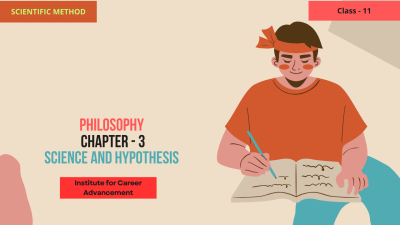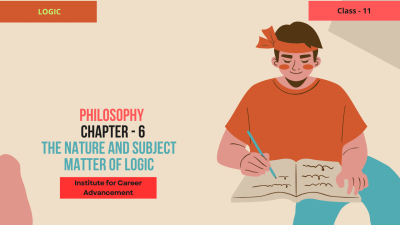Immanuel Kant's Deontology - Class 12
Studying Immanuel Kant's Deontology in Class 12 is crucial for several key reasons: Understanding Ethical Foundations: Duty-Based Ethics: Deontology introduces students to a fundamentally different ethical framework, focusing on duty and moral obligations rather than consequences or character. Rationality and Autonomy: It emphasizes the importance of reason and individual autonomy in moral decision-making. Developing Critical Thinking and Argumentation Skills: Universalizability: Kant's concept of the Categorical Imperative encourages students to critically examine their actions and consider whether they could consistently will that everyone act in the same way. Identifying Contradictions: It helps students identify potential contradictions in moral rules and evaluate the consistency of their own ethical beliefs. Exploring Diverse Perspectives: Beyond Consequentialism: Deontology provides a powerful alternative to consequentialist theories like utilitarianism, broadening students' understanding of ethical frameworks. Human Rights and Justice: Kant's ideas have had a profound impact on our understanding of human rights, justice, and international law. Engaging in Meaningful Discussions: Ethical Dilemmas: Deontology provides a framework for analyzing and discussing complex ethical dilemmas, such as those related to lying, breaking promises, and the treatment of others. By studying Kant's Deontology, students gain a deeper understanding of ethical principles, develop critical thinking and argumentation skills, and are better equipped to engage in thoughtful discussions about moral issues facing individuals and society. দ্বাদশ শ্রেণিতে ইমানুয়েল কান্টের ডিওন্টোলজি অধ্যয়ন করা বেশ কয়েকটি মূল কারণে গুরুত্বপূর্ণঃ নৈতিক ভিত্তিগুলি বোঝাঃ কর্তব্য-ভিত্তিক নীতিশাস্ত্রঃ ডিওন্টোলজি শিক্ষার্থীদের একটি মৌলিকভাবে ভিন্ন নৈতিক কাঠামোর সাথে পরিচয় করিয়ে দেয়, পরিণতি বা চরিত্রের পরিবর্তে কর্তব্য এবং নৈতিক বাধ্যবাধকতার দিকে মনোনিবেশ করে। যুক্তিবাদিতা এবং স্বায়ত্তশাসনঃ এটি নৈতিক সিদ্ধান্ত গ্রহণে যুক্তি এবং ব্যক্তিগত স্বায়ত্তশাসনের গুরুত্বের উপর জোর দেয়। সমালোচনামূলক চিন্তাভাবনা এবং যুক্তি দেওয়ার দক্ষতার বিকাশঃ সর্বজনীনকরণঃ কান্টের ক্যাটেগোরিকাল ইম্পারেটিভের ধারণাটি শিক্ষার্থীদের তাদের ক্রিয়াকলাপগুলি সমালোচনামূলকভাবে পরীক্ষা করতে এবং বিবেচনা করতে উত্সাহিত করে যে তারা ধারাবাহিকভাবে প্রত্যেকে একইভাবে কাজ করতে পারে কিনা। দ্বন্দ্ব সনাক্তকরণঃ এটি শিক্ষার্থীদের নৈতিক নিয়মের সম্ভাব্য দ্বন্দ্বগুলি সনাক্ত করতে এবং তাদের নিজস্ব নৈতিক বিশ্বাসের সামঞ্জস্য মূল্যায়ন করতে সহায়তা করে। বিভিন্ন দৃষ্টিভঙ্গি অন্বেষণ করাঃ ফলস্বরূপবাদের বাইরেঃ ডিওন্টোলজি উপযোগবাদের মতো ফলস্বরূপবাদী তত্ত্বগুলির একটি শক্তিশালী বিকল্প প্রদান করে, যা নৈতিক কাঠামো সম্পর্কে শিক্ষার্থীদের বোঝাপড়া বিস্তৃত করে। মানবাধিকার ও ন্যায়বিচারঃ মানবাধিকার, ন্যায়বিচার এবং আন্তর্জাতিক আইন সম্পর্কে আমাদের বোধগম্যতায় কান্টের ধারণাগুলি গভীর প্রভাব ফেলেছে। অর্থপূর্ণ আলোচনায় অংশ নেওয়াঃ নৈতিক দ্বিধাদ্বন্দ্বঃ ডিওন্টোলজি জটিল নৈতিক দ্বিধাদ্বন্দ্ব বিশ্লেষণ এবং আলোচনার জন্য একটি কাঠামো সরবরাহ করে, যেমন মিথ্যা বলা, প্রতিশ্রুতি ভঙ্গ করা এবং অন্যদের সাথে আচরণ সম্পর্কিত। কান্টের ডিওন্টোলজি অধ্যয়নের মাধ্যমে, শিক্ষার্থীরা নৈতিক নীতিগুলি সম্পর্কে গভীর ধারণা অর্জন করে, সমালোচনামূলক চিন্তাভাবনা এবং যুক্তি দক্ষতা বিকাশ করে এবং ব্যক্তি ও সমাজের মুখোমুখি নৈতিক সমস্যাগুলি সম্পর্কে চিন্তাশীল আলোচনায় জড়িত হওয়ার জন্য আরও ভালভাবে সজ্জিত হয়।
English
Last updated
Wed, 01-Jan-2025



















